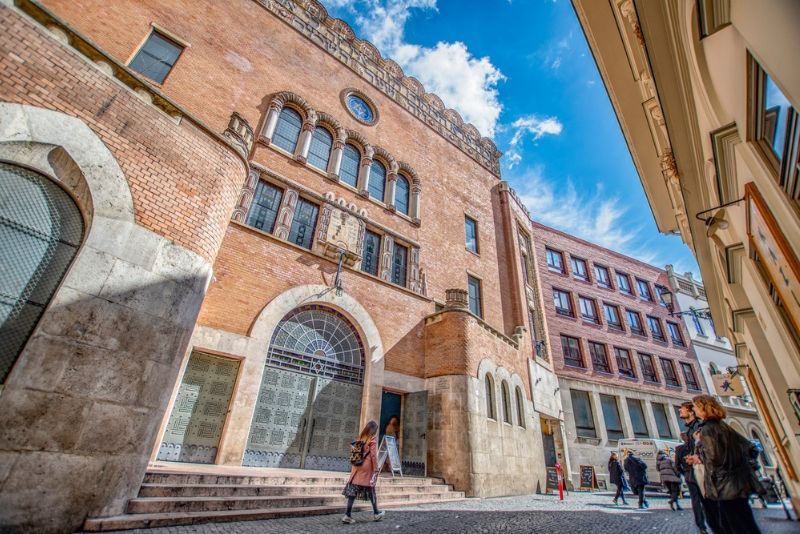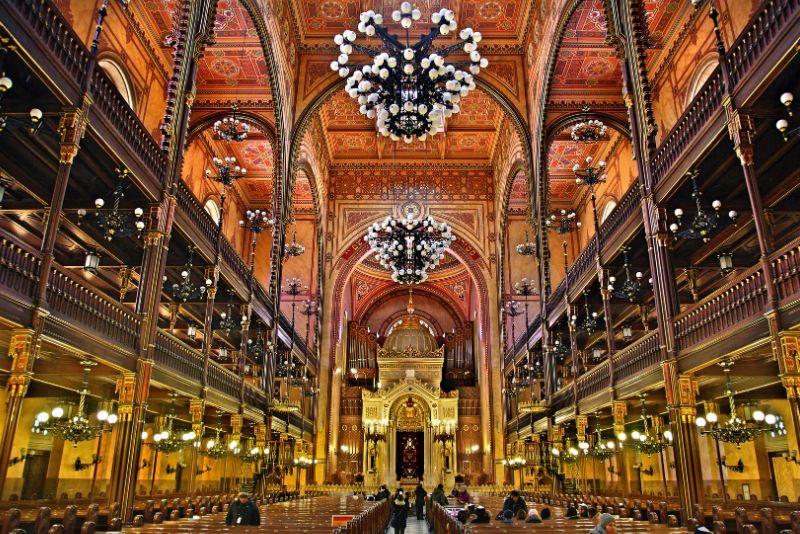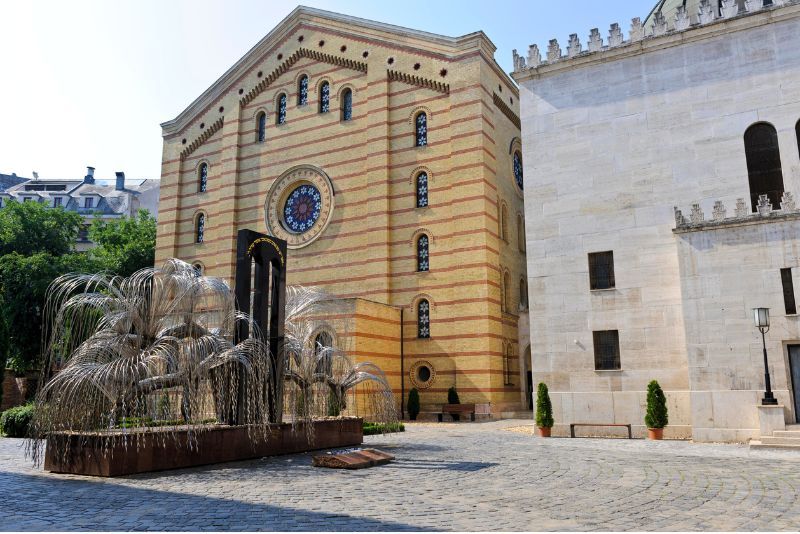Jewish Quarter: Tours and Guided Visits
The Jewish Quarter in Budapest is home to a remarkable history, and tells tales of loss, endurance and survival. There are a wealth of religious monuments that visitors can explore, which include one of the largest synagogues in the world, as well as a myriad of wartime memorials, dedicated to the brave individuals who supported the Jewish community against the Nazi regime.
By joining a Jewish Quarter tour in Budapest, you’ll be guaranteed an educational experience, learning about some of the most momentous events in the religion’s history.
The Jewish Quarter in Budapest is home to a remarkable history, and tells tales of loss, endurance and survival. There are a wealth of religious monuments that visitors can explore, which include one of the largest synagogues in the world, as well as a myriad of wartime memorials, dedicated to the brave individuals who supported the Jewish community against the Nazi regime.
By joining a Jewish Quarter tour in Budapest, you’ll be guaranteed an educational experience, learning about some of the most momentous events in the religion’s history.

(0/24) checking Musement...
The Jewish Quarter in Budapest is home to a remarkable history, and tells tales of loss, endurance and survival. There are a wealth of religious monuments that visitors can explore, which include one of the largest synagogues in the world, as well as a myriad of wartime memorials, dedicated to the brave individuals who supported the Jewish community against the Nazi regime.
By joining a Jewish Quarter tour in Budapest, you’ll be guaranteed an educational experience, learning about some of the most momentous events in the religion’s history.

Here's everything you need to know about the Jewish Quarter, one of the most fascinating attractions in Budapest.
What are the best Jewish Quarter tours?
Jewish Quarter free walking tour in Budapest

An excellent way to explore this neighborhood of Budapest is through a free walking tour of the Jewish Quarter. These excursions work on a pay-as-you-like basis and cost nothing to book. You’ll participate in a guided walk of the district and, at the end, tip your guide based on your enjoyment of the experience.
While you won’t step inside the Dohány Street Synagogue, also known as the Great Synagogue, you’ll have the opportunity to learn about the site as you admire its breathtaking exterior, featuring two lofty towers and numerous stained glass windows. You’ll discover a number of memorials and murals dedicated to the heroes who saved the lives of Hungarian Jews in WWII, including Carl Lutz and Angel Sanz Brinz, who provided Spanish passports to 5,000 Hungarian Jews so they could escape the Holocaust.
Become educated on Orthodox Judaism at the Status Quo Synagogue and finish your excursion with a visit to the Hungarian State Opera House, which holds an annual Jewish music festival.
Hungarian Jewish Museum and Dohány Street Synagogue tour in Budapest
By opting to join this Jewish Quarter tour in Budapest, you’ll gain access to the Dohány Street Synagogue complex, which is home to a number of attractions. You’ll discover the Hungarian Jewish Museum, which originally opened with just 1,500 artifacts in a downtown apartment. The most significant items were hidden during WWII, and as such, the collection you see today spans thousands of years of Jewish culture.
You’ll also discover the Raoul Wallenberg Emlékpark, dedicated to the Swedish humanitarian who managed to save thousands of Hungarian Jews from death during the Holocaust. Another landmark you must discover is the synagogue itself, built in a Moorish Revival style during the middle of the 19th century.
Private Budapest Jewish Quarter tour

Those who are seeking a more personal experience than a group tour can provide should opt for a private Jewish Quarter guided tour. You’ll be paired with a knowledgeable guide who will provide you with interesting tidbits about the district, which was one part of the city of Pest.
You’ll explore some of the most popular attractions, such as Dohány Street Synagogue, as well as sites that many visitors miss out on, including the Kazinczy Street Synagogue and the Carl Lutz memorial, honoring the Swiss diplomat who helped the city’s residents during WWII. While this tour covers several centuries, it mostly focuses on WWII, which was a horrifying yet significant part of Jewish history.
Alongside dedicated landmarks, you’ll also have the opportunity to peek into the life of a Hungarian local by wandering neighborhood hangouts including cafes, shops and courtyards. And, if a destination on the itinerary doesn’t interest you, simply inform your guide, and move on to the next spot.
Jewish cuisine and culture tour in Budapest
Those who wish to experience the Jewish Quarter through all their senses should consider participating in a Budapest food tour. You’ll sample a range of traditional Jewish foods, which include flodni — a decadent pastry that uses apple, walnuts and poppy seeds. You’ll also try turos taska, which is made by wrapping cottage cheese up in pastry parcels and sprinkling powdered sugar on top. Wash your treats down with a glass of pálinka — a fruit brandy often made using apricots or plums.
Alongside eating your way through the Jewish Quarter, you’ll also have plenty of time to sightsee. You’ll visit Dohány Street Synagogue, which is the crowning jewel of the district, as well as some of the many WWII memorials that dot the streets, the most renowned of which is the Holocaust Tree of Life commemorating 400,000 Hungarian Jews who were killed during the war.
What will you see?
Dohány Street Synagogue

Dohány Street Synagogue — often referred to as the “Great Synagogue” — is the largest synagogue in Europe and has the capacity to seat 3,000 devotees. In fact, this place of worship is the second-largest of its kind in the world, behind the Great Synagogue in Jerusalem.
The landmark was built over a period of 5 years in the 19th century and suffered substantial damage during a pro-Nazi bombing several months before WWII began. During the war, the site was commandeered by the Germans who used it as a radio base. It wasn’t until the 1990s that restorations to the synagogue began and it was reopened to the public in 1998.
Raoul Wallenberg Emlékpark

The Raoul Wallenberg Emlékpark is located within the same complex as the Dohány Street Synagogue and is dedicated to the Swedish humanitarian, Raoul Wallenberg. This hero issued numerous Swedish passports during WWII in a bid to save the lives of the Jewish community. He also hid many Hungarian Jews in Swedish-owned buildings. Wallenberg was captured during the Siege of Budapest in 1945 and disappeared, only to be declared dead 12 years later.
The park holds a memorial shaped like a weeping willow, which represents the 400,000+ lives of the Hungarian Jewish community that were lost to the Holocaust in WWII. The sculpture, created by Imre Varga, features the names of all the known individuals who died under the Nazi regime.
How much do Jewish Quarter tours in Budapest cost?
Jewish Quarter tours range in price, from free walking tours to more exclusive private tours.
As reflected in the name, a free walking tour in Budapest can be joined at no cost, but it is customary to provide a tip between €5 and €10.
A tour of the Hungarian Jewish Museum and Dohány Synagogue complex costs approximately €25 per person while a cuisine and culture tour increases in price to around €100 per person.
Private Jewish Quarter tours also cost approximately €100 per person, but your are limited to just your chosen tour group.
What is included?
Many tours in the Jewish Quarter include entry into the Dohány Synagogue complex as part of the guided tour. A tour that focuses on cuisine will include a handful of tastings as part of the price.
Where does it start?
Many tours start at Madách Imre tér or another central location which is specified on the booking page. Private tours may offer complimentary pickup from your accommodation.
How long does it last?
Jewish Quarter tours can last between 2 and 4 hours depending on the itinerary and which places are visited.
Is it wheelchair friendly?
Some Jewish Quarter are wheelchair accessible, but others, like walking tours, may not be. Check with your tour operator beforehand to ensure it is suitable to your needs.
When is the best time to visit the Jewish Quarter?
The best time to visit the Jewish Quarter is during the spring (April to June) and the autumn (September to October). The weather during these periods is usually pleasant, perfect for tours around the city. The summer (July to August) can be quite hot but is also a popular time due to various festivals and events.
Which other attractions can be visited in Budapest?
Travel tips
- When visiting Dohány Street Synagogue and other places of worship, make sure to dress respectfully, meaning no sleeveless tops, short skirts or shorts. Men may also be required to wear a kippah, which can provided at the synagogue.
- Popular attractions can get busy, especially during peak seasons. Consider booking tickets in advance to secure your spot and avoid long lines.
- For many tours you may be on your feet for hours at a time. Make sure you wear comfortable shoes.

